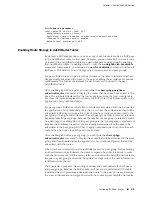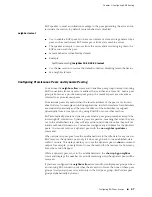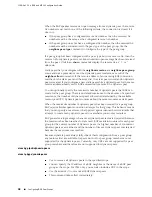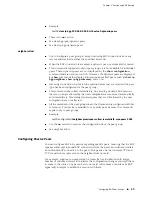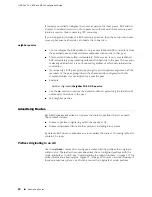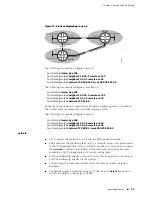
■
Use to enable MD5 authentication on a TCP connection between two BGP peers.
■
If you configure a password for a neighbor, an existing session is torn down and
a new one established.
■
If you specify a BGP peer group by using the
peerGroupName
argument, all the
members of the peer group inherit the characteristic configured with this
command unless it is overridden for a specific peer.
■
If a router has a password configured for a neighbor, but the neighbor router
does not, a message indicating this condition appears on the console while the
routers attempt to establish a BGP session between them.
■
Similarly, if the two routers have different passwords configured, a message
appears on the console indicating that this condition exists.
■
Use the
8
keyword to indicate that the password is encrypted (entered in
ciphertext). Use the
0
keyword to indicate that the password is unencrypted
(entered in plaintext).
■
This command takes effect immediately and automatically bounces the BGP
session.
■
Use the
no
version to disable MD5 authentication.
■
See neighbor password
Setting the Maximum Size of Update Messages
You can use the
neighbor maximum-update-size
command to set the maximum
size of update messages transmitted to a BGP peer.
For example, to set the maximum update size to 2,000 octets:
host1(config)#
router bgp 100
host1(config-router)#
neighbor 10.12.2.5 maximum-update-size 2000
neighbor maximum-update-size
■
Use to set the maximum size for transmitted BGP update messages.
■
Set the maximum-update-size to a range: 256–4096.
■
The default is 1024 octets.
■
If you specify a BGP peer group by using the
peerGroupName
argument, all the
members of the peer group inherit the characteristic configured with this
command unless it is overridden for a specific peer.
■
BGP always
accepts
updates of up to 4096 octets, regardless of the setting for
transmitted updated messages.
■
Applies to all update messages sent after you issue the command.
■
Use the
no
version to restore the default value.
■
See neighbor maximum-update-size.
Configuring BGP Peer Groups
■
37
Chapter 1: Configuring BGP Routing
Summary of Contents for BGP
Page 6: ...vi ...
Page 8: ...viii JUNOSe 11 1 x BGP and MPLS Configuration Guide ...
Page 37: ...Part 1 Border Gateway Protocol Configuring BGP Routing on page 3 Border Gateway Protocol 1 ...
Page 38: ...2 Border Gateway Protocol JUNOSe 11 1 x BGP and MPLS Configuration Guide ...
Page 234: ...198 Monitoring BGP JUNOSe 11 1 x BGP and MPLS Configuration Guide ...
Page 236: ...200 Multiprotocol Layer Switching JUNOSe 11 1 x BGP and MPLS Configuration Guide ...
Page 542: ...506 Monitoring BGP MPLS VPNs JUNOSe 11 1 x BGP and MPLS Configuration Guide ...
Page 544: ...508 Layer 2 Services Over MPLS JUNOSe 11 1 x BGP and MPLS Configuration Guide ...
Page 610: ...574 Virtual Private LAN Service JUNOSe 11 1 x BGP and MPLS Configuration Guide ...
Page 624: ...588 VPLS References JUNOSe 11 1 x BGP and MPLS Configuration Guide ...
Page 680: ...644 Virtual Private Wire Service JUNOSe 11 1 x BGP and MPLS Configuration Guide ...
Page 724: ...688 Monitoring MPLS Forwarding Table for VPWS JUNOSe 11 1 x BGP and MPLS Configuration Guide ...
Page 725: ...Part 6 Index Index on page 691 Index 689 ...
Page 726: ...690 Index JUNOSe 11 1 x BGP and MPLS Configuration Guide ...



















